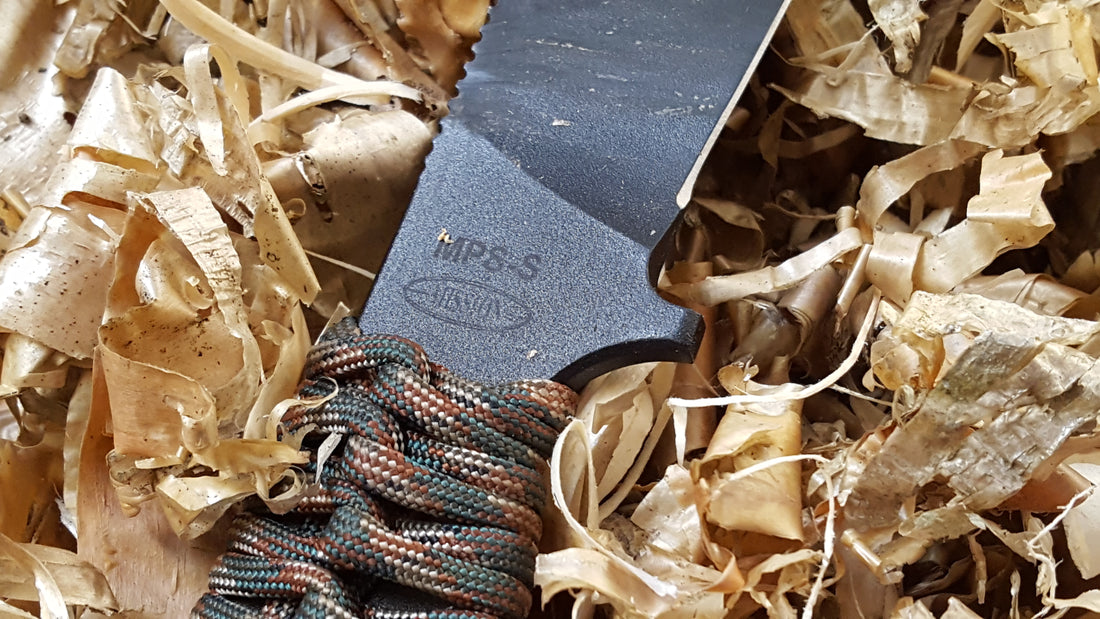By: Kevin Estela, Owner/Head Instructor of Estela Wilderness Education
Winter. If you live in a region that experiences drastic temperature changes, you know what cold weather can do to a person. From the physical response we call “shivering”, to the psychological and logical fear of hypothermia, to the emotional hatred of cold air blowing on your exposed skin or snow going down the back of your neck, winter is when Mother Nature shows her ugly side. Winter doesn’t have to be a time when we hide away indoors and hibernate until spring thaws everything out. Winter is an excellent opportunity to get outdoors when fewer people are out and about. Also, winter training is an excellent modifier to our skill sets. Mistakes we can get away with in warm weather aren’t as forgiving in cold weather. One skill in particular is always an excellent test of ability, fire starting. Recently, I set out with a MISSION Knives MPS-A2 to train some skills in the cold. What follows are the lessons I convey to my students during colder weather outings that will help you find success lighting fires in the winter months.
Find Dry Wood
As with any fire starting task, you will need to find dry fuel. Luckily, winter is a great dry environment. Sure, it is cold but it isn’t wet if it is all frozen. Whatever precipitation you encounter will likely be snow, not rain. Dry wood is easily found underneath evergreen branches, laying sideways off the ground, and inside logs. With a good knife, like the MPS-A2 I carried on this particular day, you can easily split wood and access what’s dry inside. Smaller-diameter branches can be split with a knife tip first. Larger pieces can be batoned through. Just like warm-weather fire starting, don’t confuse downed green wood with true dead and seasoned wood. Just because it is down, doesn’t mean it is dry. The water moisture you normally would be able to feel will feel cold to the touch.
Build a Platform
Assuming there is snow on the ground, prior to making any fire, you should construct a stable platform to build the fire on top of. Without a platform, your coals will slowly burn down into the snow and your fire will either sink to a depth where it goes out or where it isn’t close enough to warm you. For smaller fires, a simple platform of bark will do to hold your tinder. Fire will burn up and into your small fuel before it burns down into the snow. You can use your blade to hack off an armful of evergreen boughs as the primary layer and add another layer of wood on top of that. The evergreen boughs will eventually burn through which is why you need a secondary layer on top of it. If you can place a layer of dirt down on top of the evergreen boughs instead of a layer of wood, even better.
Forget Small Fire Starters
In the winter, sensitivity in your exposed fingers goes away pretty quickly. Throw on a pair of gloves or mittens and now you have added bulk around your digits. All that extra bulk makes it difficult to grasp onto your ferro rod and its scraper. Winter, simply put, is not the time of year to see how ultralight you can make your kit. If you’re serious about your survival, you need to think about the reality of fire starting in the worst conditions. What will improve your chances of igniting a fire is a large fire starter and a large scraper. I personally carry a ferro rod that is 3” long x ¼” to 4” long and ½” in diameter. My scraper is actually a carbide machete sharpener that digs deeply into my ferro rod and throws larger and stronger sparks than anything else I’ve tried. Speaking of sparks, the sparks you’ll generate from a larger ferro rod will dwarf those from a smaller one. In cold weather, the hotter the spark the better.
After Tinder, Think Soft Wood First then Hard Wood
There are many good tinders available in the cold and frozen forest. Birch bark, cedar duff, leftover milkweed pods, all work to take a spark from your ferro rod. These are great natural tinders but the combination of petroleum jelly and cotton balls is still king. Whenever you can, use small twigs from the underside of conifers to get your fire going. While these won’t take a spark, they will take a flame and burn very hot. Unfortunately, they also burn very fast so follow up your softwood fire with good hardwood in increasing diameters until you burn large enough fuel to keep you or your shelter warm. Hardwood fires create long-lasting coals that will provide the long-lasting heat (never long enough! Read the next tip please!) to keep you warm when the temps drop.
Collect Wood, A LOT of Wood
Whenever I winter camp, I always feel like the weekend is filled with processing wood, eating, sleeping, and processing more wood for the fire. Whenever I get a break, that is when I get to “play” with cool knives and gear. When you think you have enough wood, double it. When you double that, keep going. You will never know when bad weather is on the horizon and while you can’t “make hay while the sun shines”, you can cut wood while it isn’t freezing raining or dumping snow in a blizzard on you. With only a knife, you need to get creative with wood collection. Long dried branches too thick to break over your knee can be snapped between a “V” in a tree or you can simply burn them in half over the fire. Make sure you keep a hooked-shape staff near you in your shelter so you can tend to the fire without escaping from the cover of your lean-to or tarp.
When the temperatures drop, don’t get stuck indoors. Take your gear and skill set into the cold and learn how to adapt your warm-weather skills to meet your winter survival needs. An emergency won’t happen when conditions are favorable. It can happen at any time and during any season so make yourself better prepared for the unexpected.








